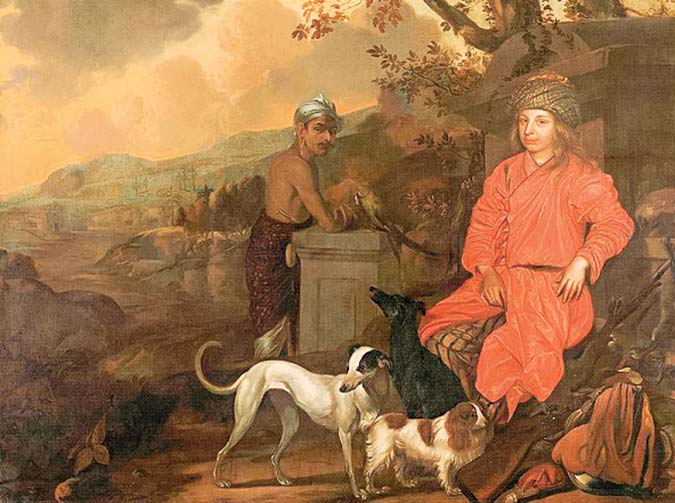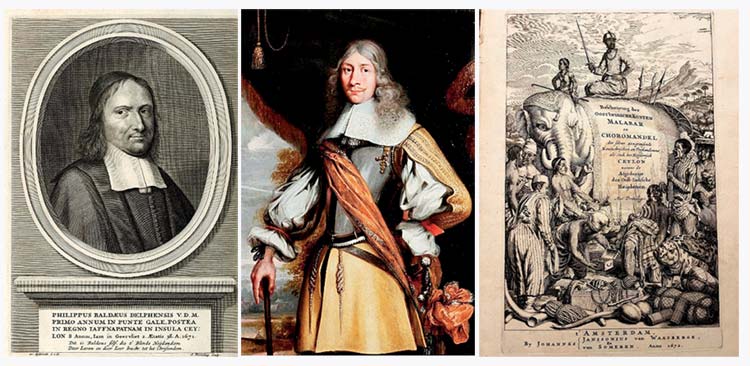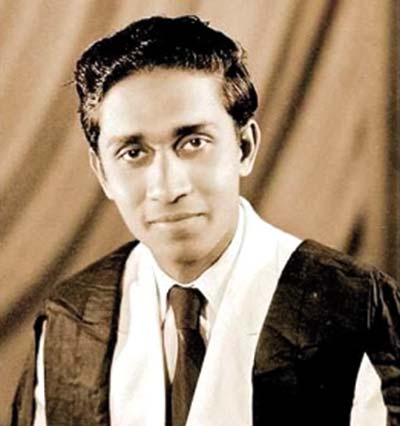Phillipus Baldaeus:the Dutch Missionary who wrote of Ceylon– By Avishka Mario Senewiratne and Dr. Srilal Fernando
Source:Island
A recent reading of the life and works of the Dutch Minister, Rev. Phillipus Baldaeus reveals a man who fits the phrase “je ne sais quoi”, a quality that cannot be described or named easily. His Magnum Opus, “A True and Exact Description of the Most Celebrated East India Coasts of Malabar and Coromandel. As also the Great Island of Ceylon and the religion of the heathens.” Published in 1672, this work is the first of three great descriptions of Ceylon. The second one by the more famous Robert Knox deals with the interior of the island close to Kandy where he was incarcerated after being taken captive. A third book by Captain Ribeiro called Ceilao was an account of a soldier, of mainly the maritime areas under the Portuguese.
Baldaeus served as a Minister of the Dutch Reformed Church and accompanied the Dutch troops when they captured Jaffna from the Portuguese. He was there from 1658 to 1665 and recorded life in Jaffna, secular and religious buildings. The land, the inhabitants, and their customs are replete with many drawings and maps. A detailed account of the capture and the ensuing military activity, as events prior to and after are included in his book. This brief essay is an attempt to illustrate the life of Baldaeus.
Early Life
Baldaeus was born in 1632 in Delft, Holland. At the age of four, he lost both of his parents to the plague, within the span of just four days. His grandfather cared for Baldaeus till he too died four years later. The care passed onto a relative Robertus Junius, who had served in the overseas missions. It is possible that young Baldaeus was influenced by Robertus to serve in the Ministry. After completing his studies at the Universities of Groningen and Leiden, Baldaeus was appointed Minister of the Dutch Reformed Church at age 21. He married his cousin and embarked for Batavia as a Dutch East India Company employee. (VOC). Unfortunately, his wife died three months after his arrival in Batavia in July 1655.
Missionary in Ceylon
After the capitulation of Colombo to the Dutch in May 1656, Baldaeus was ordered to serve in Ceylon. He married Elizabeth Tribolet on board the ship and arrived in Galle later that year. In both marriages, Baldaeus was childless. He stayed in Galle for one year mainly serving the needs of the Dutch troops and the community.
In January 1658, the Dutch launched a campaign to oust the Portuguese from South India and Northern Ceylon, under the leadership of Ryckloff van Goens (Snr). Baldaeus accompanied the troops as Chaplain. The Sinhalese force led by Mudliyar Don Manoel Andrado and his brother Don Louis Andrado joined the Dutch troops. They captured Tuticorin, and Mannar easily. On the June 21, 1658, Jaffna capitulated. The fleet sailed to Negapatam which surrendered without fighting.
Baldaeus was now appointed Predikant (Minister of the Dutch Reformed Church) of Jaffna. He had the difficult task of converting the Hindus and the many Catholics to the Dutch Reformed Church and managing the church’s affairs. This task was challenging as the Portuguese had ruled the North for over 40 years and Roman Catholicism was widespread. Dutch possessions were owned by the Dutch East India Company, the VOC. Unlike the Catholic Church under the Padroado, the Dutch Reformed Church had to function under the VOC. Baldaeus, like the other predikants were appointed by the VOC. So was another grade of clergy lower than the predikants who had to work in the parish and minister to the sick. Baldaeus had to deal with a large number of Catholics who had at one time had nearly forty priests ministering to them. All the Catholic churches and schools were vested in the Dutch Reformed Church.
Work in Jaffna
The predikant had a strong influence on the population. He could appoint schoolmasters. They could impose fines for non-attendance. The locals were required to attend. These fines were a source of income for the schools. They performed other functions such as recording births and marriages and keeping records of the Thômbos. Baldaeus was astute and a hard worker. He acquired a knowledge of Tamil and Portuguese so that he could listen to and speak with locals in their own tongue. He also preached in these languages. Later, he compiled books in these languages so that native proponents and schoolmasters could address the masses widely.
The first such book was “The Principal Precepts of our Religion”. Upon being approved by the Governor-General and Council of India as well as the Governor of Ceylon in 1659, this book was widely used in the Churches of Jaffna, Mannar, Galle, Negombo, Galle and Matara. He toiled by himself in these tasks for three years with only local assistants. Then two aides, Joannes A’ Breyl and Joannes Donker were appointed to assist him. Even with this help, the tasks were overwhelming as he had to preach three times on Sunday and once on weekdays, apart from his frequent visitations.
In 1661, Baldaeus again accompanied Ryckloff van Goens Sr. and his troops to take over Portuguese possessions on the Malabar coast. Wouter Schouten, a surgeon attached to the Dutch fleet, in his book “Oost Indische Voyagin”, records the presence of Baldaeus whom he refers to as “the pious predikant, a man faithful, zealous and unwearied in the work of the Lord”. Schouten also states that he visited and gave great comfort to the wounded. Hearing about the work of Baldaeus, Johan Maatsuycker, the Governor General of Netherlands India, wrote him a congratulatory letter. It is said that Baldaeus carried out his duties with extreme diligence.
After this brief interruption, he successfully continued his work in Jaffna. He reports the presence of over 15,000 children attending schools in Jaffna, over 62,000 Christians with many baptisms and marriages taking place. Nevertheless, these efforts were not totally fruitful as many would re-convert to their native faith of Hinduism or Catholicism. Seventy years later, the German traveller Johan Wolfgang Heydt commented the following on Baldaeus:
“I for my part have never seen any such great zeal among the local folk… In truth, Herr Baldaeus would wonder greatly should come today to these parts.”
By 1662, Baldaeus had learnt Sanskrit as well as studied Hinduism. All this he did to fathom the culture and traditions of the land he worked. Baldaeus truly loved the East, especially Ceylon. Baldaeus, though anti-Catholic, admired the methods of faith propagation by the Portuguese Catholic missionaries. He emulated them as much as he could. However, with the lack of predikants and the lack of enthusiasm, the faith of the Dutch Reformed Church did not make a sound impact in Ceylon as the Catholics. However, Baldaeus’ translation of the Lord’s Prayer to the Tamil language, although guilty of a few errors, was remarkable as the first treatise printed in Europe of any Indian language.
Challenges with the VOC
With the passing of time, he was increasingly dissatisfied with the VOC for their miserly attitude to dispensing funds, and the failure to obtain more clergy to maintain and expand the work he was doing. Unlike the Catholic missionaries who considered the Portuguese regime a separate entity, working independently yet with their protection, the Dutch missionaries were under the VOC; and employed by them. Thus, their hands were tied. Baldaeus clamoured for change. The final straw was when the authority to inspect schools was removed from the predikants and handed over to lay officials. Thus, in 1665 Baldaeus applied to Batavia for release from his duties.
As the Government of Ceylon was short of predikants, they requested Baldaeus to stay for another two years. However, he refused this request. As a result, Governor Ryckloff Van Goens Sr. was angered. He considered this refusal as an affront to the dignity and authority of the government and nearly alleged Baldaeus of financial misdeeds baselessly. Accordingly, Van Goens sent Baldaeus off in haste on the next ship to Europe. This was the inglorious end of the glorious mission in the East, of the zealous missionary, Philipus Baldaeus. He served over 10 years in the East, of which nine were in Ceylon.
Back in Europe – the final phase
After spending three months in the Cape of Good Hope Baldaeus reached Holland in 1666. Little is known about his activities in the next two years, and it can be presumed that he was working on his book on the subject of his experience of the East. He may have settled in the Hague in the late 1660s. However, through the dedication of his book, it is known that he took part in a Thanksgiving service at the Hague to celebrate the victory of Admiral de Ruyter at Chatham.
In 1669 he was appointed predikant in a small town in Holland and remained there until his death three years later. The cause or date of the death of Baldaeus is not known for sure. It is predicted that he passed away either in 1671 or 1672.
Baldaeus’ Tree
Baldaeus claims that the Church of Pariture was the finest in Point Pedro. The Dutch built a fort there which encompassed the Church and a certain tamarind tree. Baldaeus commented on it as follows: “The church was much decayed, but has been repaired of late. Just before the church stands a tall tamarind tree, under which, as it affords a very agreeable shadow in the heat of the day…”. Nearly a century after Baldaeus left Ceylon, Fredrick Schwartz a Danish missionary, made an effort to track this tree, under which the late revered preacher had preached his sermons. Later in 1906, a stone slab was set to commemorate this occasion.
Baldaeus Tree
1658
Visited by Schwartz
5th September 1760
Though the slab still remains, the celebrated tree which had a circumference of approximately 15m at the base of the trunk and 22m at the crown, was blown over by a cyclone in 1952. The church there was demolished much earlier. However, a few fragments of the fort still linger.
The book
It is widely believed that Baldaeus spent his last few years writing this monumental work on the East, with a special emphasis on Ceylon. He was able to see this work being printed in 1671, a few months before his death at 39. The book printed in folio form is divided into three sections:
· Detailed description of the East Indian coast or of Lagoon areas of Malabar and Coromandel (includes: “short guide to the time sophisticated language arts”)
· Description of the great and famous island of Ceylon
· Abgotterey of the East Indian heathen. A truthful and detailed description of the worship of the Hindus and Hindu idols.
Each of these sections had a separate title page and pagination. The section on Ceylon counts to 240 pages, with eight unnumbered pages (These pages were printed after the main section was printed but before the publishing). This section also includes 57 illustrated engravings and 11 double-page prints containing maps and views of the main cities of Ceylon. The book also contains the portraits of Baldaeus and General Gerard Hulft, engraved by the well-known artist Blooteling, based on portraits drawn by Syldervelt and Govaart Flinck.
With regard to the section on Ceylon, the first forty chapters are details of the events before 1656, which Baldaeus referred to from the Portuguese authors before his day. The first Chapter is a general description of the island, whereas chapters two to seven speak of the events of the arrival of the Portuguese to the Dutch visits in the early 17th century. The next 32 chapters speak of the arrival of the Dutch till its capture of the Coastal region in 1656. Many scholars have considered this section as important though it is guilty of certain inaccuracies. It is a great book of reference to the scholar and student of history as well as the general reader interested in the affairs of Ceylon for it is all too important in every aspect it has been written.
The last ten chapters illustrate Baldaeus’ own observation and experience as a visitor of the island. His work as a Predikant is highlighted in this aspect. These ten chapters are useful for understanding the workings of the common men and women in Jaffna, which are not recorded in other sources. Baldaeus however is faulty of his biases like any other author. Firstly, he is a Dutch Imperialist. Secondly, after all, he is a Minister of the Dutch Reformed Church and is highly biased toward his own faith and is in antipathy with the indigenous faiths. These facts are not ambiguous in his writings and even the average reader can notice them. Dr. P. J. Veth comments on Baldaeus as follows:
“The style of Baldaeus is not free from faults; his construction of sentences is often faulty, and his mode of expression is not always exact. But nevertheless, that style is deserving of high praise, when we contrast it with the manner of most of the writers of his time, at which our language even by the most able men, as a rule so badly written and disfigured by the use of so many useless foreign words.”
Nearly 250 years later, the eminent historian, Donald Ferguson critically analyzed this work in the Ceylon Literary Register of 1936. In order to understand the era of Baldaeus in a much more comprehensive way, Prof. K.W. Goonewardena’s The Foundation of Dutch Power in Ceylon 1638-1658 (1958) and Prof. Sinnappah Arasaratnam’s The Dutch Power in Ceylon 1658-1687 (1958) are essential reading material. Reading these monologues along with Baldaeus gives a better perspective on the period in question.
The Translations
The 1672 first version of Baldaeus’ work was written and printed in Dutch. The publishers of this monumental work were Johannes Janssonius Van Waasberge and Johannes Van Someren in Amsterdam. The ‘privilegie’ or copyright was signed by Johann de Witt and Herbert Van Beaumont dated March 18, 1669. The book was dedicated to Cornelius de Witt, a Dutch political and Naval commander. After the book was printed in Holland, a German version was printed by the same publishers in 1672 as well. On the title page of this version, it is stated that it was “Carefully translated”. However, despite the assurance of the publishers, the translation was not a very accurate one as the translator was ignorant of many oriental terms.
It was using this German version that the first English translation by Churchill’s in England was translated. It went under one section of Churchill’s Collection of Voyages and Travels. However, as expected this translation made the obvious mistakes the German one made. In the later 19th century, Pieter Brohier translated certain portions of Baldaeus’ work and published it in the form of a pamphlet. Later his great-grandson, Dr. R.L. Brohier republished this in the Dutch Burgher Union Journal from 1956 to 1959 as well abridged version.
When S.D. Saparamadu of Tisara Prakasakayo and Ceylon Historical Journal fame contemplated publishing a sound translation of Baldaeus’ text, Lyn Fonseka of the Colombo Museum Library informed him of another unpublished full translation by Pieter Brohier. Fortunately, the once-misplaced manuscript had been identified among several anonymously written papers in the library of the Royal Asiatic Society.
These letters were donated to the RAS by Advocate Weinman in 1897. Pieter Brohier who was born in 1792 and lived most of his life under the British had a sound knowledge of “High Dutch” as well as English. This paved the way for an excellent translation. However, Fr. S.G. Perera SJ, upon referring to the manuscript pointed out a few shortcomings.
He recommended changing the style of the language as well as maintaining the original Dutch names of various places. Realizing the importance of this unpublished manuscript, Saparamadu printed and published it for the first time in 1960. He made several changes as recommended by Fr. Perera and thus a new glossary was introduced by C.W. Nicholas pointing out the names and what they meant. This publication mooted under the able workmanship of S.D. Saparamadu is a phenomenal contribution to Sri Lankan history. Baldaeus’ legacy was sealed!
References
Ferguson, D.,
Prof. K.W. Goonewardena’s The Foundation of Dutch Power in Ceylon 1638-1658 (1958) and Prof. Sinnappah Arasaratnam’s The Dutch Power in Ceylon 1658-1687 (1958)
Saparamadu, S.D.,
Pierersz, S., (1908)










